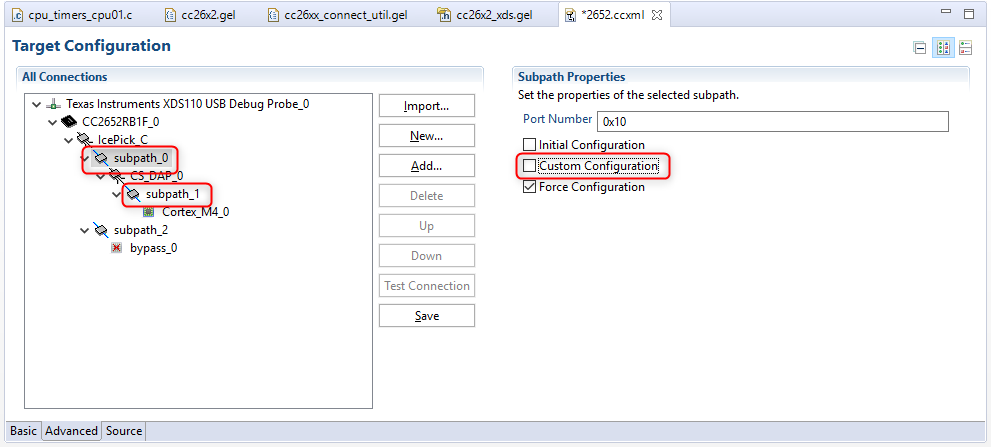Other Parts Discussed in Thread: CC2652RB, CC1310
I need to use the CLI of Uniflash to perform a MassErase on a target. I can successfully do this using SmartRF Flash Programmer 2, but I can't use that. I need to use Uniflash CLI.
In the Uniflash CLI, it mentions that in order to do a MassErase on a device with a locked debug interface you must do this:
How do you specify custom="no" in a .ccxml file? Can you give me the syntax for doing that?
Currently the CCXML file looks like this:
<?xml version="1.0" encoding="UTF-8" standalone="no"?>
<configurations XML_version="1.2" id="configurations_0">
<configuration XML_version="1.2" id="Texas Instruments XDS110 USB Debug Probe_0">
<instance XML_version="1.2" desc="Texas Instruments XDS110 USB Debug Probe_0" href="connections/TIXDS110_Connection.xml" id="Texas Instruments XDS110 USB Debug Probe_0" xml="TIXDS110_Connection.xml" xmlpath="connections"/>
<connection XML_version="1.2" id="Texas Instruments XDS110 USB Debug Probe_0">
<instance XML_version="1.2" href="drivers/tixds510icepick_c.xml" id="drivers" xml="tixds510icepick_c.xml" xmlpath="drivers"/>
<instance XML_version="1.2" href="drivers/tixds510cs_dap.xml" id="drivers" xml="tixds510cs_dap.xml" xmlpath="drivers"/>
<instance XML_version="1.2" href="drivers/tixds510cortexM.xml" id="drivers" xml="tixds510cortexM.xml" xmlpath="drivers"/>
<property Type="choicelist" Value="1" id="Power Selection">
<choice Name="Probe supplied power" value="1">
<property Type="stringfield" Value="3.3" id="Voltage Level"/>
<property Type="choicelist" Value="1" id="Power Isolation"/>
</choice>
</property>
<property Type="choicelist" Value="1" id="JTAG Signal Isolation"/>
<property Type="choicelist" Value="4" id="SWD Mode Settings">
<choice Name="cJTAG (1149.7) 2-pin advanced modes" value="enable">
<property Type="choicelist" Value="1" id="XDS110 Aux Port"/>
</choice>
</property>
<property Type="choicelist" Value="0" id="Debug Probe Selection">
<choice Name="Select by serial number" value="0">
<property Type="stringfield" Value="DANIEL01" id="-- Enter the serial number"/>
</choice>
</property>
<property Type="choicelist" Value="0" id="The JTAG TCLK Frequency (MHz)"/>
<platform XML_version="1.2" id="platform_0">
<instance XML_version="1.2" desc="CC2652RB1F" href="devices/cc2652rb1f.xml" id="CC2652RB1F" xml="cc2652rb1f.xml" xmlpath="devices"/>
</platform>
</connection>
</configuration>
</configurations>






